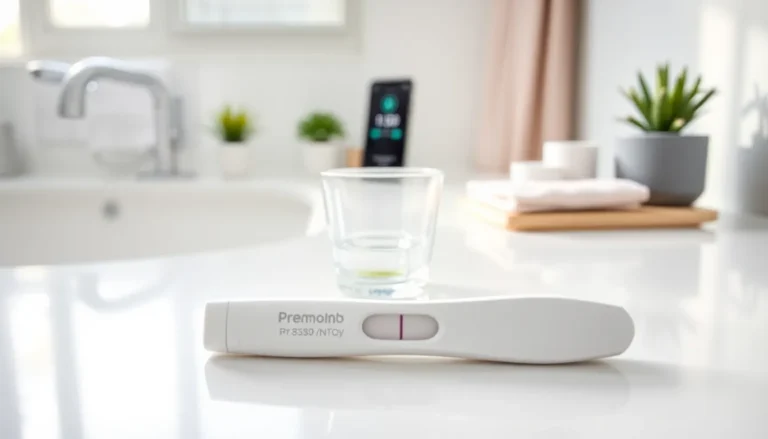Pregnancy is a journey filled with excitement, anticipation, and a sprinkle of confusion. One term that often pops up in the pregnancy lexicon is DPO, and no, it’s not a secret code for a new baby gear line. DPO stands for “days past ovulation,” a crucial marker for those tracking their cycle or trying to conceive. Understanding DPO can make the difference between counting down the days to a missed period or celebrating a positive pregnancy test.
So why should anyone care about DPO? Well, it’s like the GPS for your reproductive journey. Knowing your DPO can help pinpoint when to take that all-important test or simply ease the anxiety of waiting. Join the ranks of informed parents-to-be and dive into the world of DPO—because knowledge is power, and who doesn’t want to feel like a pregnancy pro?
Table of Contents
ToggleWhat Does DPO Stand For In Pregnancy?
DPO stands for “days past ovulation,” a term commonly used in tracking fertility and pregnancy. This timeframe begins after the ovulation event, which typically occurs around 14 days before a woman’s next expected period. Monitoring DPO helps individuals estimate when they could take a pregnancy test for reliable results.
Calculating DPO involves tracking ovulation signs like changes in cervical mucus or basal body temperature. This tracking can assist in identifying the most fertile days, increasing the chances of conception. Understanding this concept can significantly reduce anxiety around missed periods and early pregnancy detection.
Once a woman reaches 7 to 10 DPO, her body starts producing the hormone human chorionic gonadotropin (hCG) if conception occurs. Often, pregnancy tests can detect hCG levels at this stage, helping determine early pregnancy status. The wait until a missed period can feel lengthy, making knowledge about DPO even more vital for many.
It’s crucial to note that DPO does vary among individuals. Factors such as cycle length and hormonal balance can influence ovulation timing. Being aware of these variations will enable women to personalize their tracking methods, leading to improved accuracy.
Individuals seeking to conceive often prioritize understanding DPO as part of their overall fertility strategy. They can enhance their chances of conception by aligning activities during peak ovulation times with accurate DPO monitoring. Empowered choices stem from precise understanding, allowing women to navigate their reproductive health effectively.
Understanding DPO
Days past ovulation, commonly known as DPO, plays a vital role in fertility awareness. Tracking DPO enables individuals to identify their most fertile days and understand their menstrual cycle better.
Definition of DPO
DPO signifies the number of days elapsed since ovulation. Generally, ovulation occurs approximately 14 days before the onset of a woman’s next period. The calculation of DPO begins once ovulation is confirmed through various methods. Tracking fertility signs, like changes in cervical mucus or basal body temperature, enhances accuracy. Monitoring these indicators provides clarity about ovulation timing, thereby assisting in the estimation of DPO. Accurate counting starts when ovulation happens, influencing pregnancy test timing.
Role of DPO in the Menstrual Cycle
DPO directly impacts the menstrual cycle by aiding in ovulation tracking. Understanding one’s DPO helps clarify when to take a pregnancy test for the most accurate result. Hormonal changes unfold during the DPO period as the body prepares for possible conception. Specifically, the hormone human chorionic gonadotropin (hCG) begins to rise around 7 to 10 DPO if fertilization has taken place. These hormonal shifts signal the best time for testing. Therefore, recognizing the significance of DPO supports those navigating their reproductive journeys and aligns efforts with optimal fertility opportunities.
Significance of DPO in Pregnancy
Understanding DPO plays a significant role in pregnancy tracking and fertility awareness. Individuals monitoring their cycles gain valuable insights into their reproductive health through DPO.
DPO and Ovulation
DPO directly relates to ovulation, marking the time from ovulation to the current date. Ovulation typically occurs about 14 days before the expected period. Tracking this phase helps individuals determine peak fertility days. As ovulation is confirmed, counting DPO can enhance accuracy in recognizing fertile windows. Individuals benefit from observing physical signs, such as changes in cervical mucus or basal body temperature. Monitoring these signs aids in pinpointing ovulation. Individuals can then align their conception efforts with the optimal timing of fertility.
DPO and Pregnancy Testing
DPO significantly influences the timing of pregnancy tests. Optimal testing occurs around 7 to 10 DPO, coinciding with hCG hormone production if conception has occurred. Detecting hCG in urine signals a potential pregnancy. Early tests done too soon may yield false negatives due to insufficient hCG levels. By timing tests appropriately, individuals enhance their chances of accurate results. Keeping track of DPO not only reduces uncertainty but also promotes informed decision-making regarding testing. Recognizing the ideal timeframe for testing aligns individuals with successful pregnancy detection efforts.
Factors Influencing DPO
Understanding factors influencing DPO enhances tracking accuracy for individuals. Hormonal fluctuations and cycle variability play crucial roles in determining DPO.
Hormonal Changes
Hormones greatly impact DPO. After ovulation, progesterone levels rise, maintaining the uterine lining for a potential pregnancy. By around 7 to 10 DPO, a fertilized egg’s presence prompts the secretion of hCG hormone. Detecting hCG in the body makes it possible to confirm pregnancy through tests. Variations in hormonal balance can lead to differences in DPO patterns for individuals. Monitoring these hormonal changes enables better timing for pregnancy tests and provides insights into reproductive health.
Cycle Variability
Cycle length significantly affects DPO. An average menstrual cycle spans 21 to 35 days, but each person may experience variations. Tracking ovulation accurately helps in determining unique DPO for each individual. For some, ovulation occurs earlier or later, thereby shifting the DPO timeline. Irregular cycles tend to complicate DPO tracking, making it essential to embrace personalized methods. Understanding one’s cycle variability ensures precise calculation of DPO and improves overall fertility awareness.
Conclusion
Understanding DPO is essential for anyone navigating the journey of conception. By tracking days past ovulation individuals can better time their pregnancy tests and reduce the stress of uncertainty. Recognizing the hormonal changes that occur during this period empowers people to make informed decisions about their reproductive health.
Personalized tracking methods can enhance accuracy and help individuals align their efforts with their unique cycles. Whether one is trying to conceive or simply wants to understand their menstrual health better knowing DPO can be a valuable tool in achieving their goals. Embracing this knowledge can lead to a more confident and informed approach to fertility.



